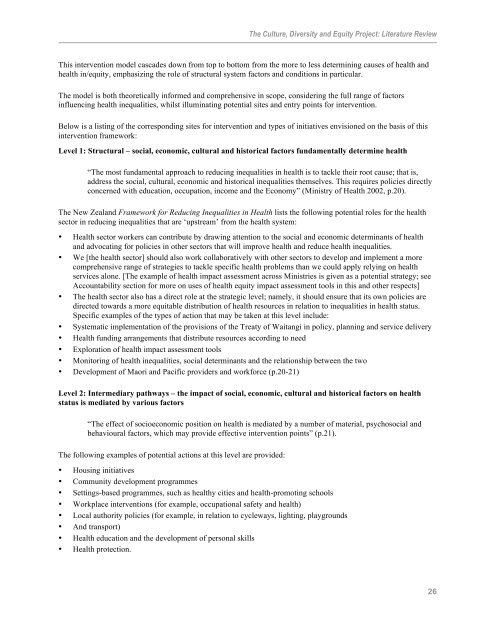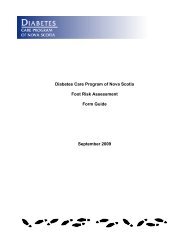CDE Appendix 1 Literature Review - Central East Local Health ...
CDE Appendix 1 Literature Review - Central East Local Health ...
CDE Appendix 1 Literature Review - Central East Local Health ...
You also want an ePaper? Increase the reach of your titles
YUMPU automatically turns print PDFs into web optimized ePapers that Google loves.
The Culture, Diversity and Equity Project: <strong>Literature</strong> <strong>Review</strong><br />
This intervention model cascades down from top to bottom from the more to less determining causes of health and<br />
health in/equity, emphasizing the role of structural system factors and conditions in particular.<br />
The model is both theoretically informed and comprehensive in scope, considering the full range of factors<br />
influencing health inequalities, whilst illuminating potential sites and entry points for intervention.<br />
Below is a listing of the corresponding sites for intervention and types of initiatives envisioned on the basis of this<br />
intervention framework:<br />
Level 1: Structural – social, economic, cultural and historical factors fundamentally determine health<br />
“The most fundamental approach to reducing inequalities in health is to tackle their root cause; that is,<br />
address the social, cultural, economic and historical inequalities themselves. This requires policies directly<br />
concerned with education, occupation, income and the Economy” (Ministry of <strong>Health</strong> 2002, p.20).<br />
The New Zealand Framework for Reducing Inequalities in <strong>Health</strong> lists the following potential roles for the health<br />
sector in reducing inequalities that are ‘upstream’ from the health system:<br />
• <strong>Health</strong> sector workers can contribute by drawing attention to the social and economic determinants of health<br />
and advocating for policies in other sectors that will improve health and reduce health inequalities.<br />
• We [the health sector] should also work collaboratively with other sectors to develop and implement a more<br />
comprehensive range of strategies to tackle specific health problems than we could apply relying on health<br />
services alone. [The example of health impact assessment across Ministries is given as a potential strategy; see<br />
Accountability section for more on uses of health equity impact assessment tools in this and other respects]<br />
• The health sector also has a direct role at the strategic level; namely, it should ensure that its own policies are<br />
directed towards a more equitable distribution of health resources in relation to inequalities in health status.<br />
Specific examples of the types of action that may be taken at this level include:<br />
• Systematic implementation of the provisions of the Treaty of Waitangi in policy, planning and service delivery<br />
• <strong>Health</strong> funding arrangements that distribute resources according to need<br />
• Exploration of health impact assessment tools<br />
• Monitoring of health inequalities, social determinants and the relationship between the two<br />
• Development of Maori and Pacific providers and workforce (p.20-21)<br />
Level 2: Intermediary pathways – the impact of social, economic, cultural and historical factors on health<br />
status is mediated by various factors<br />
“The effect of socioeconomic position on health is mediated by a number of material, psychosocial and<br />
behavioural factors, which may provide effective intervention points” (p.21).<br />
The following examples of potential actions at this level are provided:<br />
• Housing initiatives<br />
• Community development programmes<br />
• Settings-based programmes, such as healthy cities and health-promoting schools<br />
• Workplace interventions (for example, occupational safety and health)<br />
• <strong>Local</strong> authority policies (for example, in relation to cycleways, lighting, playgrounds<br />
• And transport)<br />
• <strong>Health</strong> education and the development of personal skills<br />
• <strong>Health</strong> protection.<br />
26

















